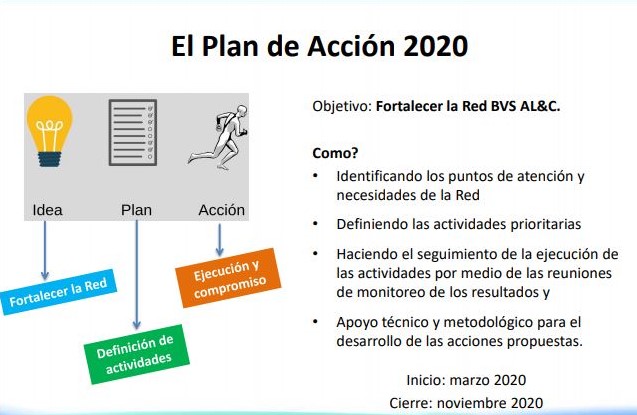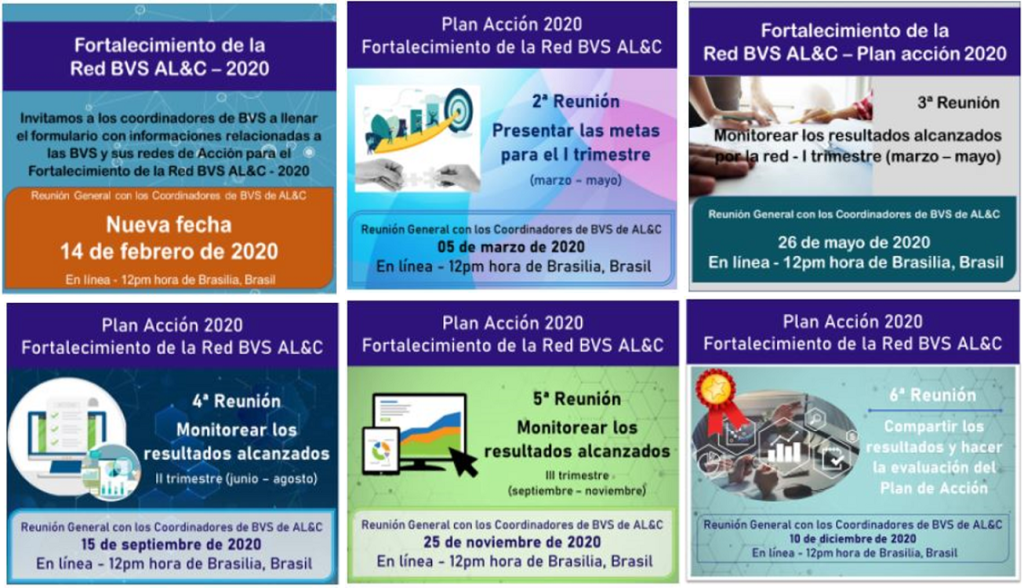On December 10, the sixth and last meeting of the Network of the Virtual Health Library (VHL) in Latin America and the Caribbean and Spain took place, which aimed to share the results of the Action Plan reached during 2020 (March-November). The results and the evaluation of all the activities of this plan were presented, as well as the challenges and the lessons learned in the development of these activities, in addition to the challenges for 2021.
The Plan’s methodology[1] consisted of defining the objective, then applying a survey to identify the points of attention and needs of the network, which formed the baselines of the plan that helped define the five priority action lines with 28 activities. For the monitoring of the Plan, meetings were held for technical and methodological support from BIREME and for monitoring the development of the proposed actions.
 The plan’s development period was nine months, from March to November 2020. The development and monitoring of activities were organized in quarters: March to May, 1st quarter; June to August, 2nd quarter; and September to November, 3rd quarter.
The plan’s development period was nine months, from March to November 2020. The development and monitoring of activities were organized in quarters: March to May, 1st quarter; June to August, 2nd quarter; and September to November, 3rd quarter.
The Action Plan strengthens the three pillars of the VHL, which are institutions, content (sources of information) and users, reflected in the VHL 2020 Guide[2], which presents the fundamentals of the VHL with the health information management model that is based on collaborative and networked work. To strengthen the VHL instances, countries were able to choose and work on the five main lines of action defined in the Action Plan 2020:
- Management of the VHL Network
- Updating and expanding the bibliographic control
- Developing or updating the VHL portal
- VHL governance
- VHL users
 The main results obtained were:
The main results obtained were:
- Six general meetings were held: two for planning and presenting the Network Plan, three for monitoring the results and providing technical and methodological support for the development of activities and one for sharing and evaluating the plan.
- Participation in monitoring meetings: 19 AL&C countries were considered in the plan, with the participation of 21 VHL instances in the network. In the three monitoring meetings, 16 countries participated in all of them.
The results were very satisfactory, since it was possible to identify the activities that had the greatest execution by the VHL and those that had the least execution, which will be evaluated and prioritized together with each country in the 2021 Plan.
Activities most performed by the VHL:
- Maintain regular contribution to the LILACS database
- Map health institutions with libraries
- Update contact information in the network directory
- Identify health information resources
- Identify technical strengths and weaknesses for information and knowledge management
- Provide training to the Network and technical and methodological support (LILACS and FI-ADMIN)
- Establish or revise / update the selection criteria
- Analyze health scientific journals in the country / subject area according to the criteria
- Map other types of publications – theses, unconventional material, books
- Develop or update the VHL portal
- Identify / map content, sources of information
- Define / adjust the information architecture of the Portal (graphic design)
- Configure a service to measure access to the portal using Google Analytics
- Map health institutions to form or reactivate the Advisory Committee
- Hold meetings of the Advisory Committee – publish the results of the meetings in the VHL
- Carry out VHL promotion / dissemination activities to users – target audience
Activities least performed by the VHL:
- Define / share responsibilities
- Create users for the new Cooperating Centers in FI-Admin
- Create national database in FI-ADMIN
- Migrate data from LILDBI databases to FI-Admin
- Establish the collaborative flow for bibliographic control in the information sources themselves (national base and others) and in LILACS
- Integrate the national database into the VHL Regional Portal
- Publish the VHL with information and graphic design
- Configure the IAHx integrated search service
- Develop showcases of knowledge linked to the priorities of the country / area
- Define Action Plan – Publish monitoring plan and reports in the VHL
- Define a strategy to increase the number of accesses to the portal
- Conduct a user study (satisfaction, identification of needs)
Countries gave their testimonies about the experience in developing the plan. Below, some of them (translated from Spanish):
“We all had problems during the year due to the pandemic, we were unable to meet in person and many things we wanted to move forward were not possible. But we made progress thanks to the BIREME team. We managed to export all the records of Peruvian literature on health sciences and we already have a Portal that will serve to show researchers that scientific information is registered on the VHL Regional Portal. In 2021, we will continue to work together!”. Fernando Ardito, Peru VHL.
“This Action Plan seemed fabulous to me, it seemed like a task that accompanied us more, so it makes us feel more united. It was a good strategy congratulations.” Ana Lorena, Colombia VHL.
“We could not have achieved these results without this guide that gave us this Action Plan and this training guide. With that, we would like to thank the entire BIREME team. We were happy with the results because the Action Plan gave us a very clear guide on what we can work on, it even served us not only for the VHL issue, but also to work on other areas that we could incorporate from our library. Thank you very much, we are willing to continue working next year.” Martha García, Honduras VHL.
“We are very grateful for the work you have done this year, coordinating actions in all VHLs, especially ours, each institution had a thematic VHL and we have not reached an agreement on a National VHL that is so necessary and that we can work next year. Colleagues who continue to work on the Committee are very willing to continue with the Action Plan.” Carina Patrón, Dentistry VHL Uruguay.
“Thank you for all the support that BIREME has given us with this Plan, which has served us well as a model. We would like to continue this Plan. Their support was essential for PAHO Paraguay and the country’s VHL Network.” Epifanía Gómez, Paraguay VHL.
“We are happy with this Plan and with the support of the BIREME team for its development.” Ofelia Mamani, INS VHL Peru.
The closing meeting was attended by Diego González, Director of BIREME, who congratulated the managers of BIREME and their teams for their participation and support for the development of the Plan and the VHL Network for the excellent and detailed work carried out, which has allowed for progress and also show that it is a network of successes and increasingly justifies that BIREME is on the right path, using the network as a strategy for the development of collaborative products and networking. González stressed the importance of how this work allowed to identify strengths and weaknesses and to advance in some countries that did not have VHL instances.
Related news
The LA&C VHL Network defines its Action Plan for 2020. Available from: https://boletin.bireme.org/en/2020/03/29/the-lac-vhl-network-defines-its-action-plan-for-2020/
[1] VHL Network Regional Portal. Fortalecimiento de la Red BVS AL&C – Plan Acción 2020. Available from (only in Spanish): http://red.bvsalud.org/modelo-bvs/es/fortalecimiento-de-la-red-bvs-alc-plan-accion-2020/
[2] VHL Network Regional Portal. Guia de la BVS 2020. Available from (only in Spanish): http://red.bvsalud.org/modelo-bvs/wp-content/uploads/sites/3/2020/12/BVS_Guia_final_30set2020_tradu%C3%A7%C3%A3o_espanhol.pdf